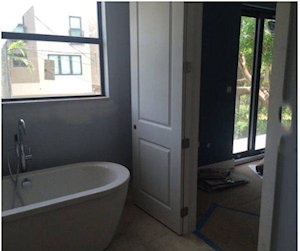Protecting yourself and your property, please read…
Before I became a licensed contractor while studying for my test, I got a call out of the blue regarding a drywall job. I was advertising as a handyman on Craigslist. So I show up at some house in downtown Sacramento and proceeded to go check out this potential job. The couple that was there, showed me where they wanted to have a wall built up on top of another wall and make this wall go all the way up to the ceiling. While checking it out and taking notes, I noticed that there were some other people there in this empty house walking someone around.
So as we continued to talk, various other requests where coming in such as can you do tile? We want some laminate flooring and so on. So I kept on taking notes as my gut started to get uncomfortable. After they showed me approximately $3000 of work, I asked them if they had an email address and that I would send some prices to them later. I left, went to my truck and crumbled up the notes including the email address and drove away. I was not legally qualified to bid on all that work as a handyman and I am pretty sure that I had been called into what the Contractors State License Board calls (SWIFT) which is short for Statewide Investigative Fraud Team.
I would have been an illegal contractor if I priced out those jobs, while they should have been protecting themselves The CSLB puts on the SWIFT construction stings to catch illegal contractors and in turn, protect you the consumer.
What is illegal contracting? Illegal contracting activity is an unlicensed person performing work on a project valued at $500 or more in combined labor and material costs (Yes, including materials!). This practice is not only illegal, but is also unfair competition for licensed contractors who operate with bonds, insurance and other responsible business practices.
CSLB’s warning on Owner/builder…
Anyone who talks you into being your own general contractor, or “owner/builder,” may be doing you no favor. “Owner/builder” describes a situation in which the homeowner becomes the general contractor.
As an owner/builder, you (not the person you hire) assume responsibility for the overall job. You should be protecting yourself.
Your responsibilities may include such things as state and federal taxes, workers’ compensation insurance, and other legal liabilities. You may be required to hire various subcontractors for your project, scheduling their work and supervising the job. If a worker is injured while working on your property, you could be asked to pay for injuries and rehabilitation through your homeowner’s insurance policy. By signing a building permit application as an owner/builder, you assume full responsibility for all phases of your project and its integrity.
Hiring an unlicensed “consultant” to manage the project does not save you money in the long run. By hiring a licensed experienced contractor for your project to hire licensed knowledgeable tradespersons, the contractor becomes responsible for all phases of construction. Unless you are very experienced in construction, it is best to leave these matters to your licensed contractor.
How you can hire someone while protecting yourself…
-Check the contractor license number at www.cslb.ca.gov to make sure it is current and in good standing.
-Ask to see the contractor’s pocket license and a current photo ID.
-Get at least three contractor bids and references.
-Ask whether your contractor carries general liability insurance and workers’ compensation insurance for employees.
-Make sure all project materials and expectations are spelled out and signed in a written contract, including clean-up, debris removal, and site security.
-Ask your contractor if he or she understands your project expectations.
-Schedule and document each phase of your project and the corresponding payment schedule.
-Do not let payments get ahead of the work. Pay no more than 10% down or $1,000, whichever is less.
-Try researching your contractor’s name online for additional reviews.




Recent Comments